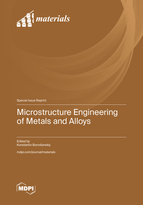Microstructure Engineering of Metals and Alloys
A special issue of Materials (ISSN 1996-1944). This special issue belongs to the section "Metals and Alloys".
Deadline for manuscript submissions: closed (10 June 2023) | Viewed by 15285
Special Issue Editor
Interests: functional and bioactive coatings; microstructural engineering; materials for solid oxide fuel cells; metallurgy; Al alloys; metallic properties
Special Issues, Collections and Topics in MDPI journals
Special Issue Information
Dear Colleagues,
Metals and alloys are a class of materials which combines high mechanical properties as strength, ductility, and stiffness with high physical properties as electrical and thermal conductivity. These materials are generally split into ferrous (steels and cast irons) and non-ferrous alloys (aluminum, magnesium, titanium, copper, nickel, zinc and other).
Both material’s structure, formed of one, two or more phases and structural defects (vacancies, dislocations, grain boundaries, and other) affect their properties. Therefore, microstructure engineering is an effective approach to achieve a desired performance of metals and alloys. Moreover, this topic attracts researchers all around the globe who focus on different aspects of structure formation including processing, alloying, and tailoring of a production condition.
Metallic microstructure observation is being commonly carried out using optical microscope. However, from the middle of the 20-th century, electron microscopy (EM) became a more effective method of structural evaluation. Microstructure characterization with EM makes available “deep view” into the metal. Thus, recent progress in understanding of structural formation of some metals may be referred to development and implementation of electron microscopy. However, this tool is not the exclusive, other available techniques are also valuable in understanding of the metallic structure. Thus, X-ray and electron diffraction analysis responsible for the phase detection, and electron backscatter diffraction provides crystallographic information.
The scope of the Special Issue will focus on recent innovations in the field of microstructure engineering of metals and alloys. Topics include, but are not limited to:
- Ferrous and non-ferrous alloys
- Metals fabrication
- Alloying and modification
- Microstructural evaluation
- Optical and electron microscopy
- Coatings and surfaces
- Metal joining processes
- Modeling and simulation of metallic materials
I invite you to submit a manuscript, which can be in the form of a full paper, communication, or a review to this Special Issue.
Prof. Dr. Konstantin Borodianskiy
Guest Editor
Manuscript Submission Information
Manuscripts should be submitted online at www.mdpi.com by registering and logging in to this website. Once you are registered, click here to go to the submission form. Manuscripts can be submitted until the deadline. All submissions that pass pre-check are peer-reviewed. Accepted papers will be published continuously in the journal (as soon as accepted) and will be listed together on the special issue website. Research articles, review articles as well as short communications are invited. For planned papers, a title and short abstract (about 100 words) can be sent to the Editorial Office for announcement on this website.
Submitted manuscripts should not have been published previously, nor be under consideration for publication elsewhere (except conference proceedings papers). All manuscripts are thoroughly refereed through a single-blind peer-review process. A guide for authors and other relevant information for submission of manuscripts is available on the Instructions for Authors page. Materials is an international peer-reviewed open access semimonthly journal published by MDPI.
Please visit the Instructions for Authors page before submitting a manuscript. The Article Processing Charge (APC) for publication in this open access journal is 2600 CHF (Swiss Francs). Submitted papers should be well formatted and use good English. Authors may use MDPI's English editing service prior to publication or during author revisions.
Keywords
- microstructural evaluation
- metals and alloys
- phase composition
- optical and electron microscopy
- coatings and surfaces
- mechanical, chemical, and physical properties
- metal fabrication processes
- modification and alloying processes
- welding, brazing, soldering and other joining process in metals
- modeling and simulation of metallic materials







